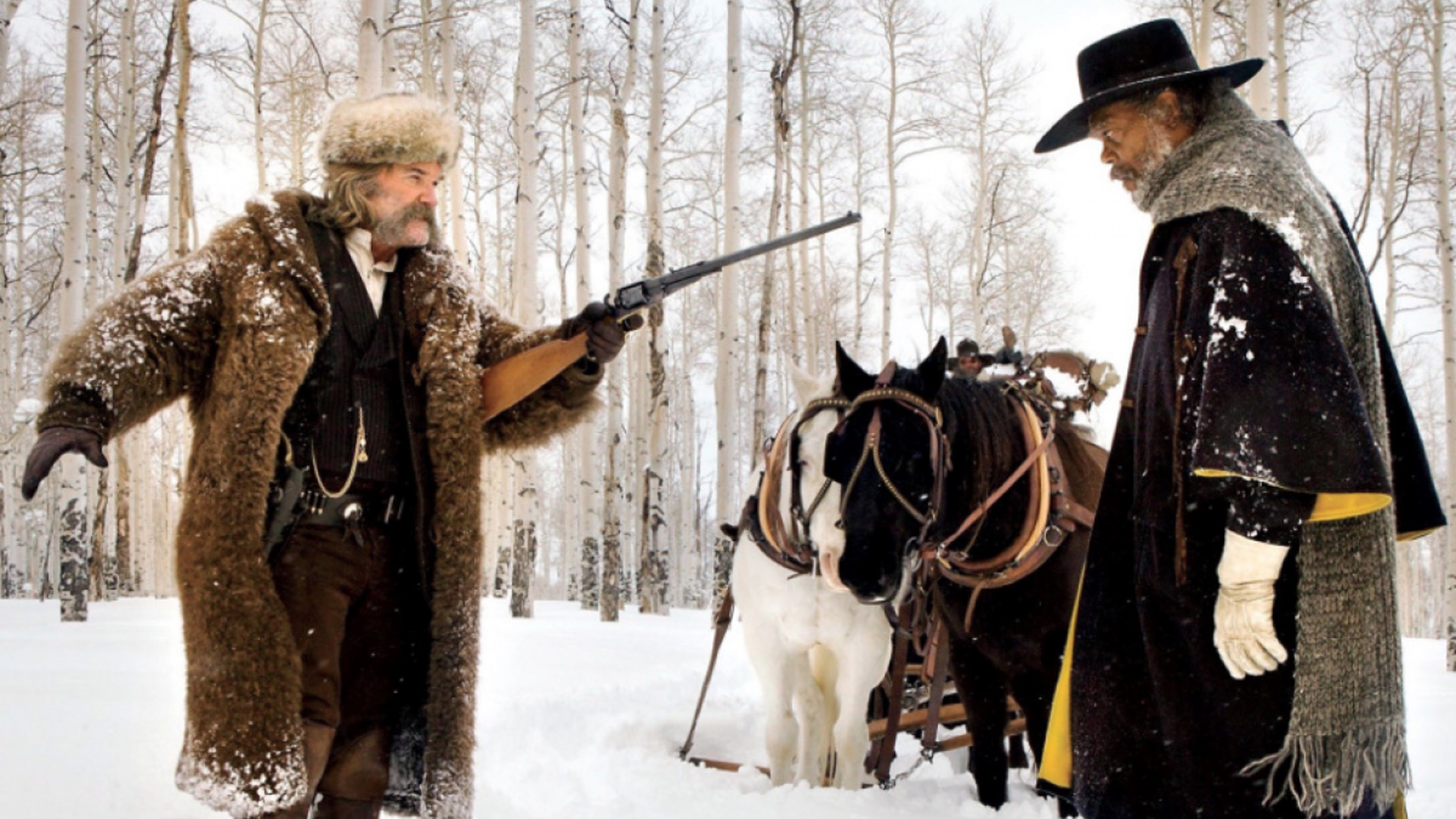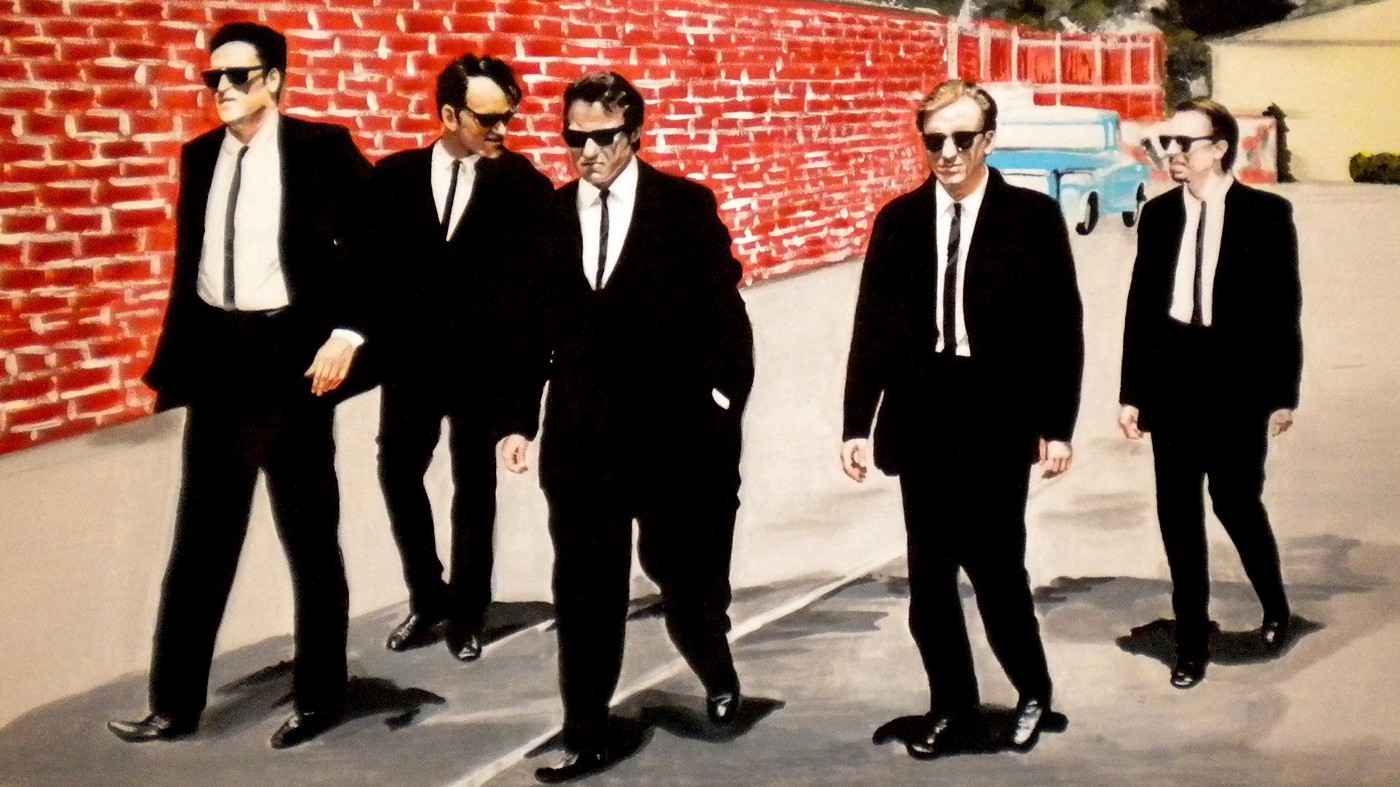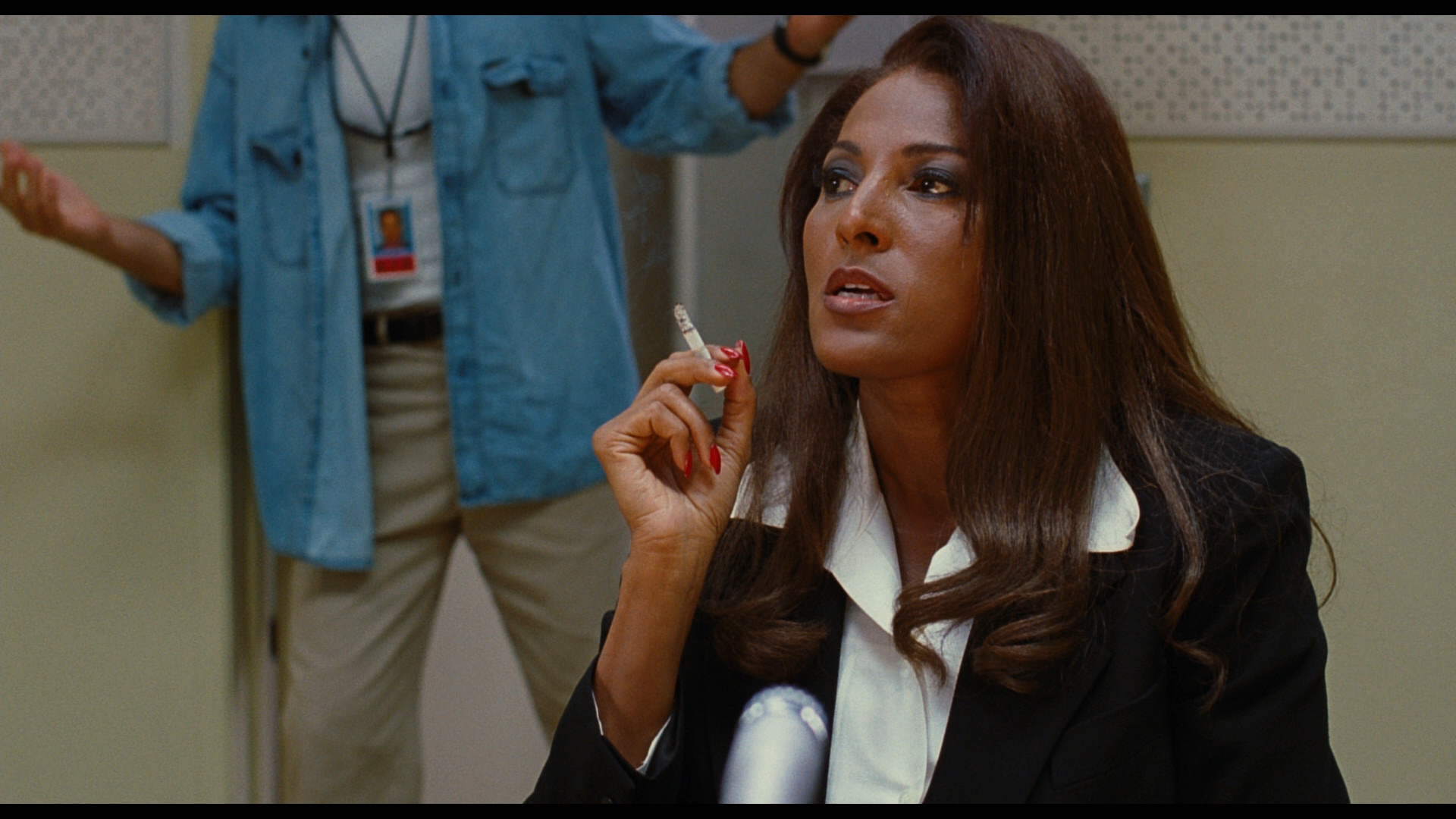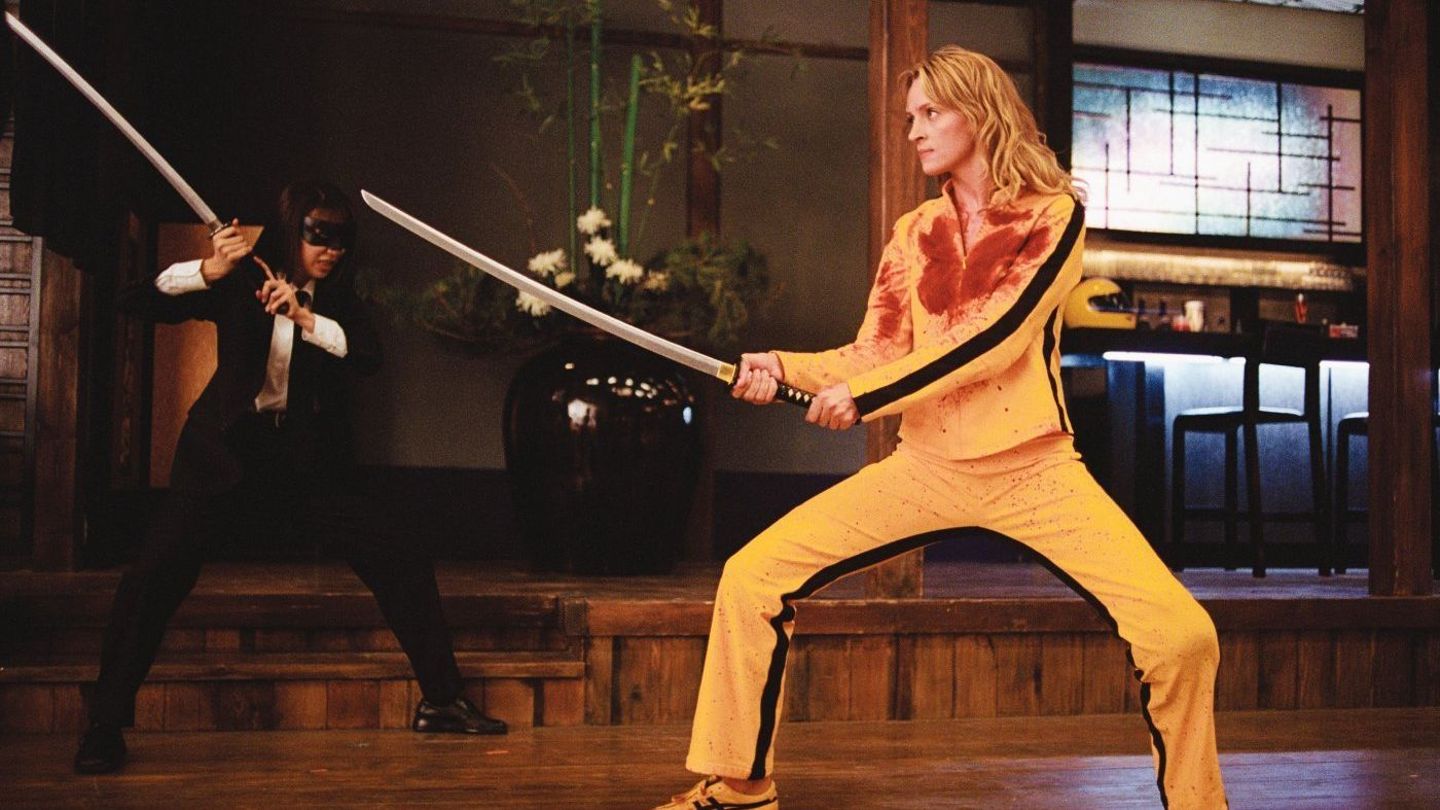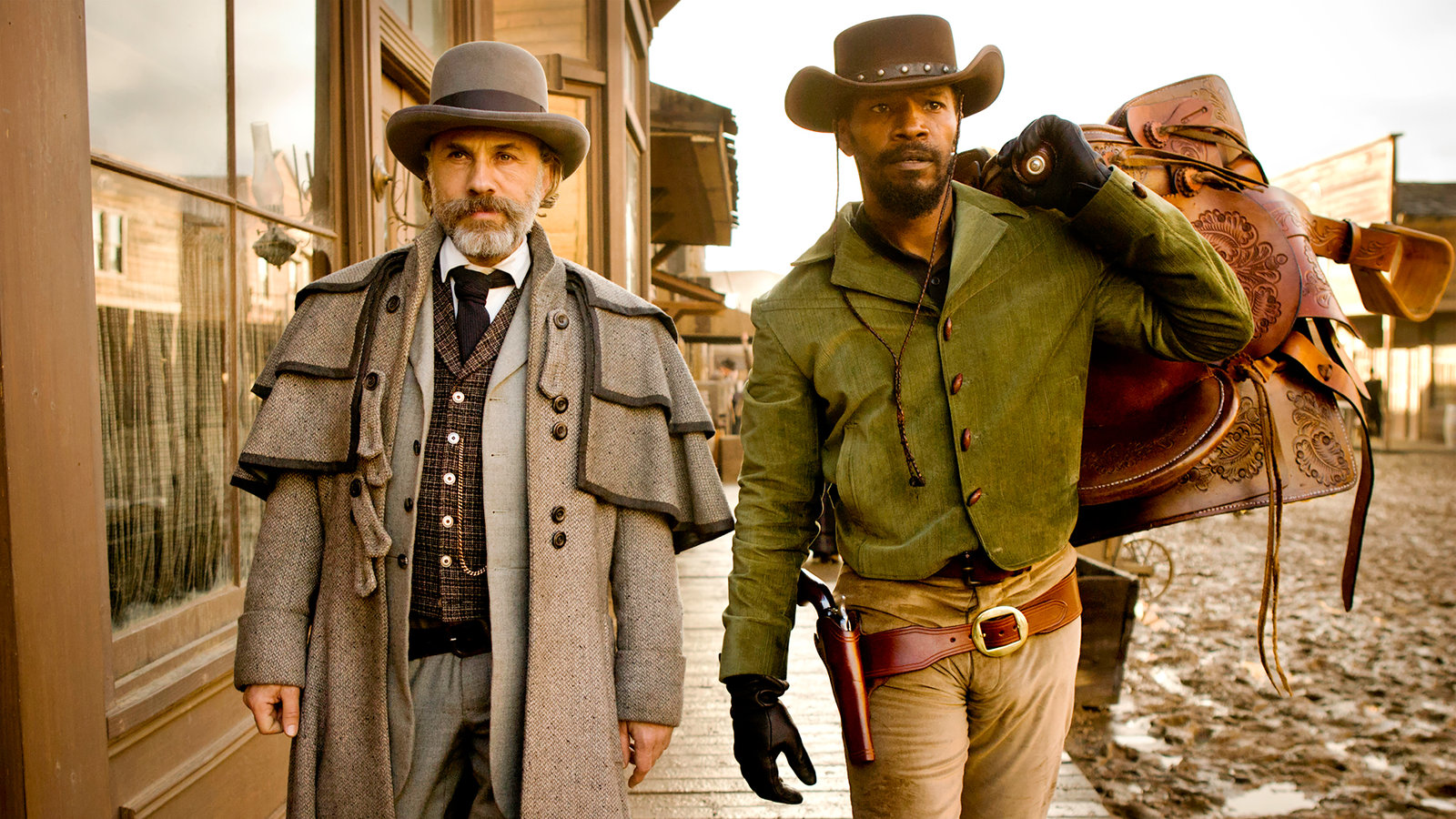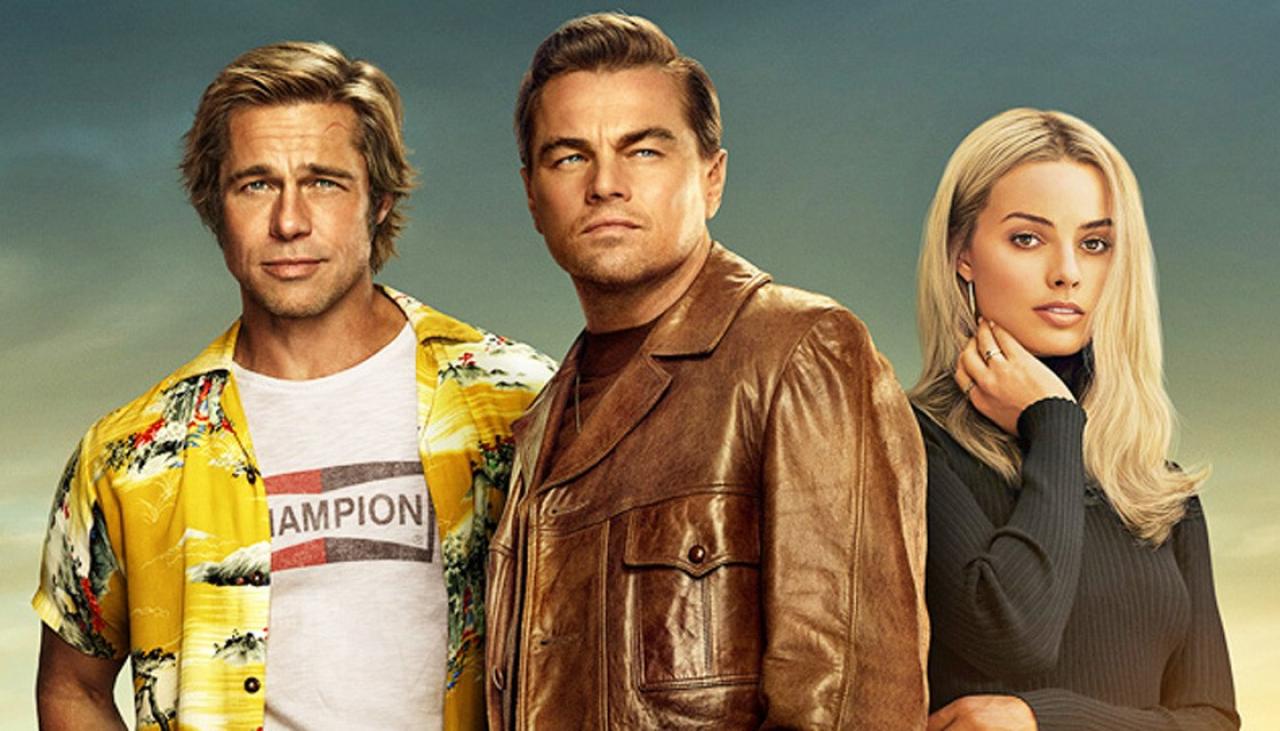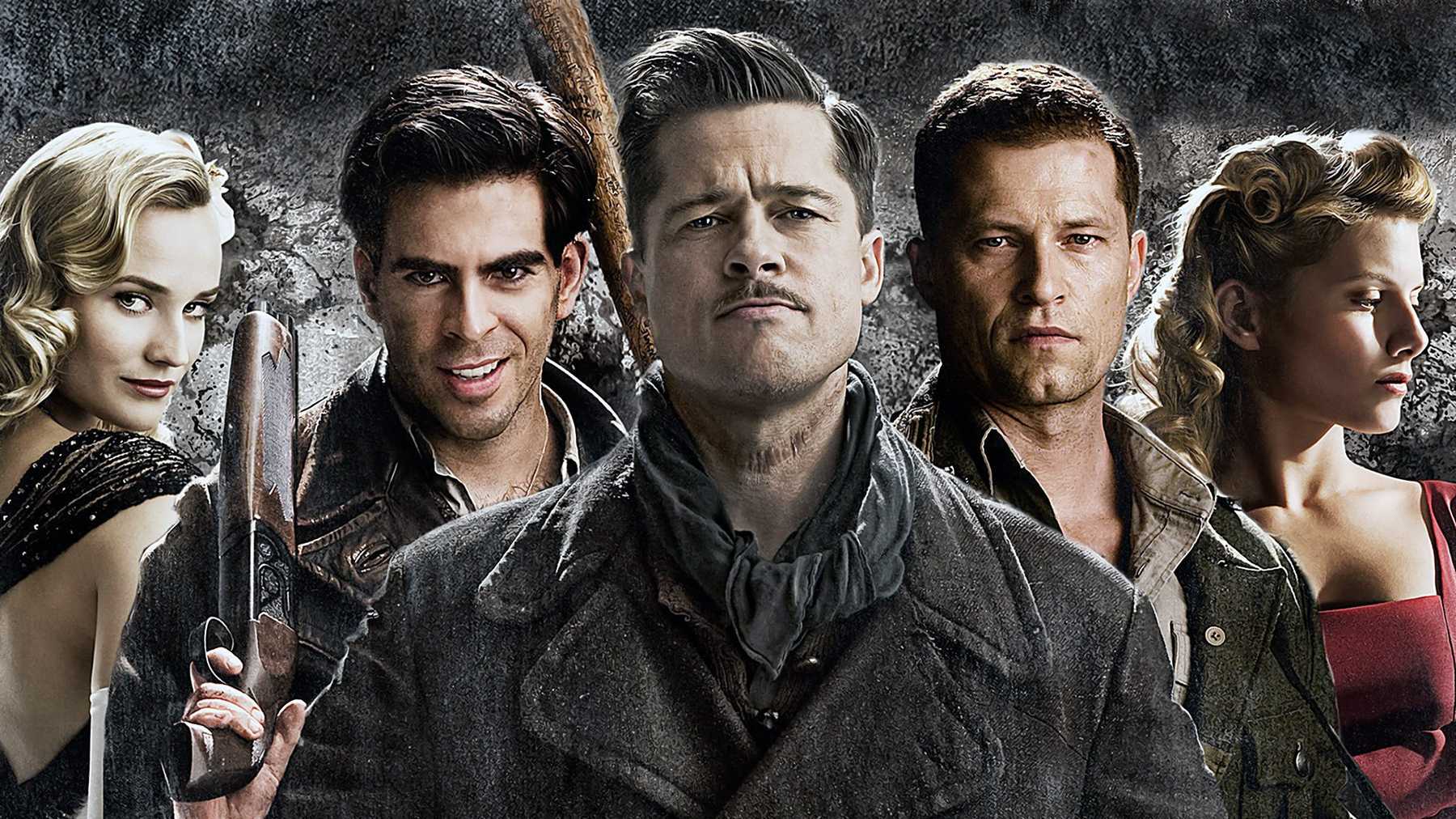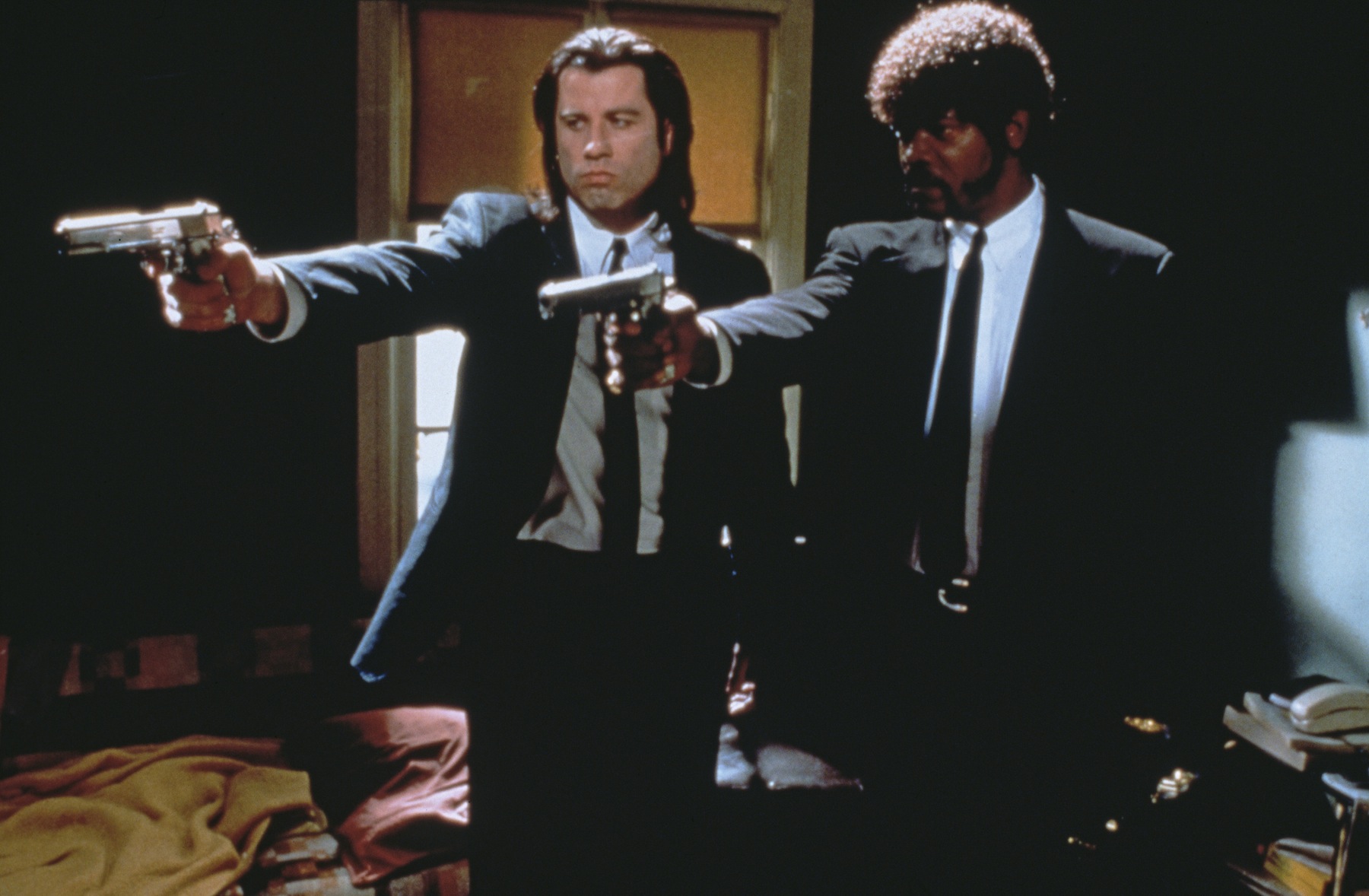So with Once Upon A Time In Hollywood making its way into theatres this week, we figured that now would be a good a time as any to take stock of the man’s career. The adrenaline pumping highs and some of his lesser accomplishments because, at least for us, Tarantino has yet to truly shell out a “bad” film. Heck, even his weakest entries will easily outdo any other wannabe crime thriller any day of the week. The man is up there with the Coens, Paul Thomas Anderson and Mann. So without further ado, we’re counting down all of Tarantino’s films from worst to best! Keep in mind that we’ll be only counting Tarantino’s standalone films, the ones he’s directly written and directed. So double features like Grindhouse and his partial involvement in films like Sin City or Natural Born Killers will not be taken into account. Cool? Cool.
8. The Hateful Eight
Again we’d like to reiterate that when we say “worst”, it is light of the man’s body of work and canon. So if you think The Hateful Eight is a fine and maybe even a great entry, then we’re mostly on the same page here. We merely think the premise lacks some of the ambition and style we’ve come to know and love in his other films. Its premise is centred around eight very dangerous and morally repugnant people waiting out a storm in a cabin with a murderer looking to see them all dead within their midst. There are some highlights in the film, a good majority of them coming from Samuel L. Jackson’s Major Marquis Warren. Until this day, I can’t get that story of him making that white racist general’s son trudge with him through the snow. And when Marquis offered the boy a blanket in exchange for some…stimulation (I’ll leave it there), he all but too quickly took it. After all that humiliation, Marquis still killed the boy. Damn, that’s some icy, cold shit.
When sh*t finally hits the fan, it’s less of an uber shootout than it is an intense interrogation at gunpoint with folks in the cabin figuring out who the killer is. The mystery gets enough mileage with the audience slowly but surely learning the identities of the titular eight. Each of them bearing some mysterious past, some of them fabricated and a lot them, downright diabolical. Where the film falters, however, is when the big reveal does take place, Tarantino seems to struggle to take the rest of the plot to any more meaningful developments before his big finale. It’s still a satisfying release but in a way, it felt like the film blew its load before hitting its supposed crescendo. I still highly recommend the film to those learning to craft witty and interesting dialogue because The Hateful Eight is firing on all cylinders in that department.
7. Reservoir Dogs
As far as directorial debuts go, Quentin has set a high bar for his career with Reservoir Dogs. The film has a fairly self-contained plot: a robbery gone wrong (or on purpose perhaps) and someone within the group isn’t exactly who he says he is. Somebody gets shot, people get nervous and you can cut the tension in the room with a butter knife. Who’s the mole? Is somebody keeping the stash for themselves? Things are about to pop off and no one is safe. How Tarantino sets Dogs apart from other crime films during the time was through his adoption of non-linear storytelling first introduced by Akira Kurosawa during the ’50s. We see how each member of the heist team got involved in the job, their motivations and eventually as the plot unfolds, the mole is revealed.
Reservoir Dogs is Tarantino at his most inexperienced and still he manages to avoid the amateurish pitfalls of overreaching in terms of scale and sweeping narratives. He borrows inspiration from more established filmmakers like Scorsese and Kurosawa, while at the same time he keeps the cast to a minimal, making his bolder ideas more manageable. So what do we get? We get a simple plot that steadily becomes complicated. A cast of competent actors delivering well-written dialogue and captivating performances. Then, when while we’re resting on our laurels, thinking to ourselves, “Hey, this is a pretty good film”, he hits with the good stuff with a Mexican standoff and some stylish violence. The man would continue to refine his technique over the years to cinematic perfection but even at his most tender he has already displayed more talent and focus than most directors can only hope to achieve in their lifetime.
6. Jackie Brown
It truly is a crying shame that Jackie Brown isn’t mentioned as much as Tarantino’s other films. I suppose part of its cult appeal within Tarantino’s already existing niche is how different and experimental it feels. There are no grand shootouts or web of subplots. Before Soderbergh took the world by storm with Ocean’s 11, there was Jackie Brown which follows a down-on-her-luck air stewardess, played Pam Grier, trapped between a rock and a hard place. The rock being the Bureau of Alcohol, Tobacco, Firearms and Explosives (ATF) and a dangerous gunrunner by the name of Ordell played by Samuel L. Jackson. After getting pinched for smuggling cash by the ATF and living under the thumb of Ordell, she decides that enough is enough. So with the aid of a very helpful bondsman, she turns the tables on all of them. They tried to use her in their games, but they’re about to learn a hard lesson. You don’t mess with Jackie Brown.
Ironically enough, the film that strays the farthest away from Tarantino’s format is his most straight forward. It takes the double-crosses of Reservoir Dogs and expands it to new territory. Pam Grier as the eponymous Jackie Brown is excellent. She’s streetsmart in every sense of the word, knowing when to posture strength to appeal to male bravado and when to be diplomatic. Pam Grier’s Jackie Brown is a bad bitch with a heart of gold. So while she isn’t exactly Kiddo Beatrix (we’ll get to her soon) or Shoshanna from Inglourious Basterds, the lady still kicks ass.
5. Kill Bill Vol. 1 and 2
Alright, so we’re going to cheat here for a bit and count both Kill Bill Vol. 1 and 2 as a single entry on this list. It’s sort of a Lord of the Rings situation in which the films are so interwoven within the overall story that its near impossible to count them as separate instalments. When it comes to badass female characters in cinema there are three names that come to my mind. They are Linda Hamilton’s Sarah Connor, Sigourney Weaver’s Ellen Ripley and finally Uma Thurman’s Beatrix Kiddo from Kill Bill. The film is Tarantino’s love letter to martial arts and Chanbara cinema, all wrapped up in a neat yellow killing machine. On the happiest day of Beatrix’s life, her wedding, she had everything taken from her by former mentor and lover, Bill. He along with his trio of female assassins thought they killed her…but they were wrong. Nothing can keep the Bride down. She will have her vengeance. She will kill Bill.
The choreography within the Kill Bill duology is some of Tarantino’s most elaborate fights the man has ever put to screen. From bloody katana battles to eye-ripping, heart exploding kung fu, Thurman under his direction has given us one of the greatest female anti-heroes in all of cinema. It’s obvious that the man wanted to take the idea of Charlie’s Angels and turn it on its head with Charlie being an insane, manipulative bastard. Kill Bill is the ultimate feminist power trip and it is hard not to gush when Thurman stands there with her Hanzo Hattori blade. It might not exactly be his most thought-provoking entry and frankly, it doesn’t need to be because it is action extravaganza of the highest order.
4. Django Unchained
So this is a tough one to discuss. On the one hand, there’s an argument to be made for Tarantino taking a rather sensitive and painful chapter of American history and essentially reducing it down into one big cathartic merry-go-round of cracker-killing violence. Then on the other, there are those that feel like Django Unchained serves to exorcise the haunting spectre of Africa American exploitation through revenge fantasy. In our humble opinion, we believe Tarantino has done both and did it with absolute style and fun. Yes, he essentially uses the dehumanizing aspects of slavery to appeal to revenge fantasies but he also gave the black characters agency and the capacity for both good and evil. This isn’t a black-good-white-bad affair. This is a story of one man playing against an existing power structure to save the woman he loves.
We see Jamie Foxx’s Django at times looking the other way to the oppression of his people, and at times even encouraging it, believing that it’ll enable him to get to his lover. Then there’s Christoph Waltz’s Dr King Schultz who is sympathetic to the plight of African-American slaves but is also a bounty hunter. It’s these shades of grey that gives the film the leeway to revel in its blood and gore without ever having to romanticize racial violence. As for the actual violence and action on display here, it is a whole lot of spaghetti western fun coupled with all the kinetic flair of a John Wu film. Django Unchained’s dense subject matter can be a tad inaccessible to those with more delicate dispositions but screw them. If Jackie Brown is Tarantino’s homage to blaxploitation then Django is his subversion of it. Though this isn’t Tarantino at his biggest or brightest, it’s him at his most unapologetic.
3. Once Upon A Time In Hollywood
This is where I must respectfully disagree with our resident film critic Dashran’s review of Once Upon A Time In Hollywood. This is easily one of his greatest masterpieces of all time! Don’t let the glitz and glamour of Hollywood in the late 1960’s fool you, this isn’t just a stellar period piece with thrilling alternate history thrown in. Oh no, this is Tarantino at his metatextual best! The character of Rick Dalton, played by Leonard DiCaprio, honestly feels like DiCaprio playing a heightened and caricatured version of himself and I bloody love it! In a lot of ways, it mirrors the actor’s passion for the craft and frustration for recognition. For goodness sake, the man has worked from Scorsese to Spielberg to Nolan to Tarantino before finally landing that Oscar with Ignaritu in The Revenant. It’s such a ball to see him channel in all out in such a hilarious, self-aware way. And though this isn’t our top pick, let me tell you something: this Tarantino’s funniest film to date. Unlike Hobbs and Shaw, there’s no ego here between actors. From the highest ranks of Hollywood royalty to lowliest of extras, everyone gets a chance to make an absolute ass of themselves. Throughout the first two acts I found myself thinking, “This is such a great film from the performances to the cinematography to the dialogue…but something’s missing.” Then the third act kicked in and boy howdy! What a hell of a way to close out a film. I mean holy dog sh*t on a stick! I don’t want to give too much away but let’s just say, things get pretty hairy and pretty trippy pretty quickly. Obviously, the dynamic duo of Pitt’s Cliff Booth and DiCaprio’s Rick Dalton are the shining stars of this romp but I do want to take the time to applaud some of the supporting cast here who went the extra mile. Mike Moh, Julie Butters and Mikey Madison take a bow!
2. Inglourious Basterds
“I think this just be my masterpiece”, those are the final words echoed by the infamous Nazi Hunter of Apache-Jew descent, Lieutenant Aldo Raine. Fittingly enough, that is the exact sentiment shared by Quentin Tarantino about Inglourious Basterds. If Once Upon A Time Hollywood is Tarantino at his most celebratory, then Basterds is Tarantino at his most ambitious. The opening scene itself already sets such a high bar for what is to come with Christoph Waltz’s Hans Landa ruthlessly and gleefully gunning down a group of Jews hiding in a French village. The thing is the actual shooting is the least painful part of the whole scene, not to take anything away from the phenomenal action here. It is the frighteningly civil conversation/interrogation Landa that prefaces the horror. In a single scene, Tarantino has managed to tell you the entire premise of the film without having it ever explained. He’s told us the main antagonist, his motivations, the superiority complex of the party he represents and power they wield. Brilliant.
This nuance in dialogue juxtaposed with the razor-sharp focus of the violence perpetrated leaves the entire experience of watching the film feeling one is sitting on a ticking time bomb. it is the hallmark of a great spy film, one of the many genres Inglourious Basterds inhabit. This ticking time bomb pacing isn’t merely for suspense, however. It can be utilized for humour like when the sombre exchange between Tim Roth’s Bear Jew and a Nazi officer suddenly snaps off into a violent and gut-busting riot with him beating the officer to death while pretending he’s in a baseball game. There are many reasons why Tarantino’s Inglourious Basterds is an amazing film but personally, I feel the one thing the director has “mastered” in his masterpiece is the art of suspense and his dynamic application of it. So why isn’t our top pick then? Well, as much we absolutely love Tarantino’s Basterds, we feel it’s just a hair short of another one of his classics.
1. Pulp Fiction
In spite of the fact that Tarantino considers Inglourious Basterds to be his magnum opus, I have to disagree with the man. I believe Pulp Fiction to be his greatest piece thus far. Here we see him pay homage to legendary Japanese director Akira Kurosawa’s mind-bending film, Rashomon. A pioneer into the structure of non-linear storytelling and Tarantino brought to the shores of the US and popularized it. Arguably he did it first in Reservoir Dogs but it really gained traction in Pulp Fiction. All the Tarantinoisms we’ve come expect spawned mostly from the framework of Pulp Fiction. Wisecracking, philosophical banter between average joes who are secretly competent badasses? Check. Intimidating monologues with quotes appropriated from religion, myth and literature before someone lets loose? You know it man. Oh, and insane over the top violence breaking the silence which leaves us laughing at the chaos and absurdity of everything around us? Hells yes. Until today, people use Pulp Fiction as the standard for great dialogue and delivery and there a ton of iconic moments here.
Some of them include a quaint British couple exchanging pleasantries before sticking up an entire diner, Vincent’s not-so-platonic night out with the Boss’ wife and of course we have my man Sam. L and his epic execution of Brett. The best part of it all is just how balanced the entire experience is due to the pacing. Tarantino manages to move a scene from charming to tense to charming before having explosive encounters that leave us in utter shock and awe. I think the aptest way I can describe Pulp Fiction is simply the world as Tarantino sees it. That beneath the mundane ebbs and flows of our dreary lives, the potential for action, intrigue and complexity lurk, waiting to be exposed. So for introducing generations to a world of colourful chaos, visceral violence and delicious doublespeak dialogue, we gotta give the crown to 1994’s Pulp Fiction.
